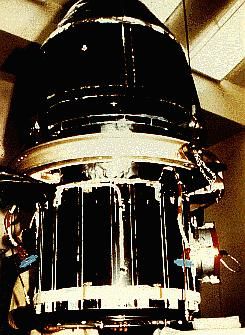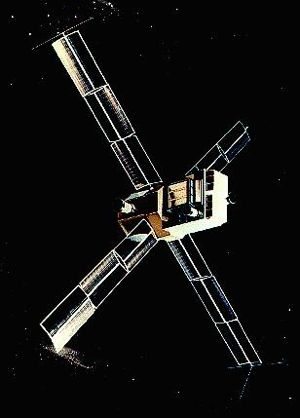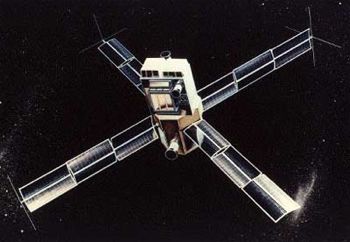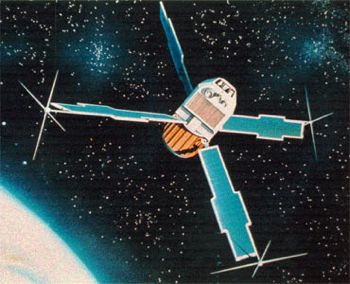
Home - Search - Browse - Alphabetic Index: 0- 1- 2- 3- 4- 5- 6- 7- 8- 9
A- B- C- D- E- F- G- H- I- J- K- L- M- N- O- P- Q- R- S- T- U- V- W- X- Y- Z
SAS
 Explorer 48 / SAS Credit: NASA |
AKA: Small Astronomy Satellite. Status: Operational 1970. First Launch: 1970-12-12. Last Launch: 1975-05-07. Number: 3 . Gross mass: 174 kg (383 lb).
NASA NSSDC Master Catalog Description
Uhuru (SAS-A) was the first in the series of small spacecraft whose objectives were to survey the celestial sphere and search for sources radiating in the X-ray, gamma-ray, UV, and other spectral regions. The primary mission of Uhuru was to develop a catalog of celestial X-ray sources by systematic scanning of the celestial sphere in the energy range from 2-20 keV.
The spacecraft was launched 12 December 1970 from the San Marco platform off the coast of Kenya, Africa, into a near-circular equatorial orbit. The orbiting spacecraft was in the shape of a cylinder approximately 56 cm in diameter and 116 cm in length. Four solar paddles were used to recharge a 6 amp-h, eight-cell, nickel-cadmium battery, and to provide power to the spacecraft and experiment. The spacecraft was stabilized by an internal wheel, and a magnetically torqued commandable control system was used to point the spin axis of the spacecraft to any point of the sky. The aspect sensing system consisted of both a star and sun sensor that shared the same processing electronics. The system was designed with heavy emphasis on redundancy, not only in the more obvious areas such as aspect sensors and high- and low-voltage power supplies, but also in signal switching and high-voltage distribution. The resulting instrument was capable of sustaining several simultaneous major failures without seriously compromising the scientific objectives. Data were stored on a one-orbit storage tape recorder and telemetered during a 3.4 minute playback cycle. A 1000 bps PCM/PM system was used.
NASA NSSDC Master Catalog Description
SAS-C was the third in the series of small spacecraft whose objectives were to survey the celestial sphere for sources radiating in the X-ray, gamma-ray, UV, and other spectral regions. The primary missions of SAS-C were to measure the X-ray emission of discrete extragalactic sources, to monitor the intensity and spectra of galactic X-ray sources from 0.2 to 60 keV, and to monitor the X-ray intensity of Scorpio X-1.
The spacecraft was launched from the San Marco platform off the coast of Kenya, Africa, into a near-circular, equatorial orbit. This spacecraft contained four instruments: the Extragalactic Experiment, the Galactic Monitor Experiment, the Scorpio Monitor Experiment, and the Galactic Absorption Experiment. In the orbital configuration, the spacecraft was 145.2 cm high and the tip-to-tip dimension was 470.3 cm. Four solar paddles were used in conjunction with a 12-cell nickel-cadmium battery to provide power over the entire orbit. The spacecraft was stabilized along the Z axis and rotated at about 0.1 deg/s. Changes to the spin-axis orientation were by ground command, either delayed or in real time. The spacecraft could be made to move back and forth plus or minus 2.5 deg across a selected source along the X axis at 0.01 deg/s. The experiments looked along the Z axis of the spacecraft, perpendicular to it, and at an angle.
NASA NSSDC Master Catalog Description
SAS-B was the second in the series of small spacecraft designed to extend the astronomical studies in the X-ray, gamma-ray, ultraviolet, visible, and infrared regions. The primary objective of the SAS-B was to measure the spatial and energy distribution of primary galactic and extragalactic gamma radiation with energies between 20 and 300 MeV. The instrumentation consisted principally of a guard scintillation detector, an upper and a lower spark chamber, and a charged particle telescope.
SAS-B was launched from the San Marco platform off the coast of Kenya, Africa, into a nearly equatorial orbit. The orbiting spacecraft was in the shape of a cylinder approximately 59 cm in diameter and 135 cm in length. Four solar paddles were used to recharge the 6 amp-h nickel-cadmium battery and provide power to the spacecraft and telescope experiment. The spacecraft was spin stabilized, and a magnetically torqued commandable control system was used to point the spin axis of the spacecraft to any position in space within approximately 1 degree. The experiment axis lay along this axis allowing the telescope to look at any selected region of the sky with its plus or minus 30 degree acceptance aperture. The nominal spin rate was 1/12 rpm. Data were taken at 1000 bps and could be recorded on an onboard tape recorder and simultaneously transmitted in real time. The recorded data were transmitted once per orbit. This required approximately 5 minutes.
The telescope experiment was initially turned on November 20, 1972, and by November 27, 1972, the spacecraft became fully operational. The low-voltage power supply for the experiment failed on June 8, 1973. No useful scientific data were obtained after that date. With the exception of a slightly degraded star sensor, the spacecraft control section performed in an excellent manner.
Family: Astronomy, Medium earth orbit, Solar. Country: USA. Launch Vehicles: Scout, Scout B, Scout D-1, Scout F-1, Scout D. Projects: Explorer. Launch Sites: San Marco. Agency: NASA. Bibliography: 2, 279, 4065, 6.
 | Explorer 53 / SAS Credit: NASA |
 | Uhuru Credit: NASA |
 | Explorer 53 Credit: Manufacturer Image |
 | Explorer 48 Credit: Manufacturer Image |
 | Explorer 42 Credit: Manufacturer Image |
1970 December 12 - . 10:53 GMT - . Launch Site: San Marco. LV Family: Scout. Launch Vehicle: Scout B.
- Explorer 42 - . Payload: SAS A. Mass: 143 kg (315 lb). Nation: Italy. Agency: NASA Greenbelt. Program: Explorer. Class: Astronomy. Type: Solar satellite. Spacecraft: SAS. Decay Date: 1979-04-05 . USAF Sat Cat: 4797 . COSPAR: 1970-107A. Apogee: 570 km (350 mi). Perigee: 521 km (323 mi). Inclination: 3.00 deg. Period: 95.50 min. Spacecraft engaged in research and exploration of the upper atmosphere or outer space (US Cat B). .
1972 November 15 - . 22:13 GMT - . Launch Site: San Marco. LV Family: Scout. Launch Vehicle: Scout D-1.
- Explorer 48 - . Payload: SAS B. Mass: 185 kg (407 lb). Nation: USA. Agency: NASA Greenbelt. Program: Explorer. Class: Astronomy. Type: Solar satellite. Spacecraft: SAS. Decay Date: 1976-08-20 . USAF Sat Cat: 6282 . COSPAR: 1972-091A. Apogee: 526 km (326 mi). Perigee: 526 km (326 mi). Inclination: 1.00 deg. Period: 95.20 min. Spacecraft engaged in research and exploration of the upper atmosphere or outer space (US Cat B). .
1975 May 7 - . 22:45 GMT - . Launch Site: San Marco. LV Family: Scout. Launch Vehicle: Scout F-1.
- Explorer 53 - . Payload: SAS C. Mass: 195 kg (429 lb). Nation: USA. Agency: NASA Greenbelt. Program: Explorer. Class: Astronomy. Type: Solar satellite. Spacecraft: SAS. Decay Date: 1979-04-09 . USAF Sat Cat: 7788 . COSPAR: 1975-037A. Apogee: 507 km (315 mi). Perigee: 498 km (309 mi). Inclination: 3.00 deg. Period: 94.70 min. Spacecraft engaged in research and exploration of the upper atmosphere or outer space (US Cat B). .
Back to top of page
Home - Search - Browse - Alphabetic Index: 0- 1- 2- 3- 4- 5- 6- 7- 8- 9
A- B- C- D- E- F- G- H- I- J- K- L- M- N- O- P- Q- R- S- T- U- V- W- X- Y- Z
© 1997-2019 Mark Wade - Contact
© / Conditions for Use